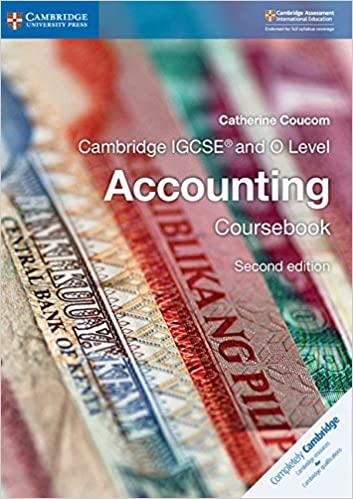Question
1. Which of the following would not be reported as investment property? a. Property owned by the entity and leased out under one or more
1. Which of the following would not be reported as investment property?
a. Property owned by the entity and leased out under one or more operating leases.
b. Property held by the entity to be leased out under one or more operating leases
c. Real estate held for an undetermined future use.
d. Property owned by the entity and leased out to another entity under a finance lease.
2. All of the following do not qualify as investment property, except
a. Machineries that are held for lease
b. Hotels or motels
c. Agricultural land purchased for appreciation purposes
d. Equipment purchased for an indeterminate purpose
3. A property is classified as investment property if
a. it is leased out under a finance lease.
b. the owner-occupied portion of the property is significant.
c. the entity provides relatively insignificant ancillary services (e.g., security, janitorial services, and the like) to the occupants of the property.
d. it is rented between a parent entity and a subsidiary and consolidated financial statements are prepared for the group.
4. How does the fair value model differ from the revaluation model?
a. Increases in carrying amount above a cost-based measure are recognized in equity
b. Changes in fair value are recognized in profit or loss
c. a and b
d. neither a nor b
5. Which of the following generally provides the best evidence of fair value of an investment property?
a. Discounted cash flow projections based on reliable estimates of future cash flows.
b. Recent prices on less active markets with adjustments to reflect changes in economic conditions.
c. Current prices for properties of a different nature or subject to different conditions.
d. Current prices on an active market for similar property in the same location and condition.
6. Select the correct statement.
a. A leasing company should treat all its assets used in providing lease services as investment property.
b. Investment properties that are to be disposed of without further development are treated as investment property until they are derecognized.
c. All investment properties held for capital appreciation will be classified as held for sale in the long run.
d. Investment properties being re-developed as investment properties on behalf of third parties are investment properties.
7. A change in the amortization rate for an intangible asset should be accounted for
a. by retrospective restatement.
b. by retrospective application.
c. on a prospective basis.
d. on a current basis.
8. If a franchise becomes worthless before the end of its useful life, the carrying amount of the franchise account should be charged as
a. franchise expense in the current period.
b. a prior period adjustment.
c. impairment loss.
d. amortization expense.
9. Which of the following is a true statement concerning research and development (R&D) costs?
a. All R&D costs, without exception, must be charged to expense when incurred.
b. R&D costs can only be amortized over a life of 40 years or more.
c. Almost any treatment is acceptable for handling R&D costs.
d. Financial statements must disclose total R&D costs charged to expense in the period
10. Which of the following is an unidentifiable asset?
a. Goodwill
b. Private-to-private franchise
c. Deferred charges
d. Unearned rent
11. In accordance with the PFRSs, which of the following methods of amortization is normally not recommended for intangible assets?
a. Units of production
b. Declining balance
c. Effective interest method
d. Straight line
12. Which of the following costs related to computer software is capitalized to an intangible asset account?
a. Costs of duplication and reproduction of software for sale
b. Development costs before technological feasibility is achieved
c. Coding and testing costs incurred to establish technological feasibility
d. Coding and testing costs incurred after technological feasibility is established but before the product master is completed
Step by Step Solution
There are 3 Steps involved in it
Step: 1

Get Instant Access to Expert-Tailored Solutions
See step-by-step solutions with expert insights and AI powered tools for academic success
Step: 2

Step: 3

Ace Your Homework with AI
Get the answers you need in no time with our AI-driven, step-by-step assistance
Get Started


